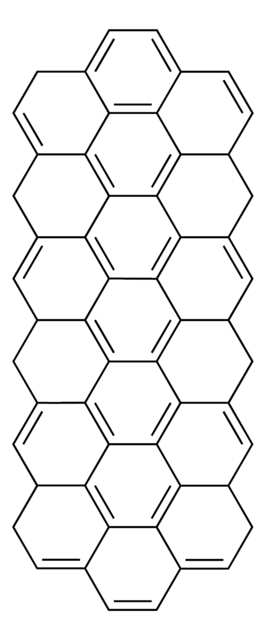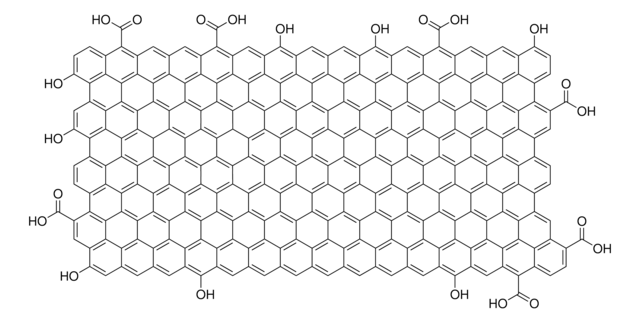922676
Graphene nanoribbon
oxidatively splitted from CNT
Synonym(s):
GNRs, Graphene nanoribbon made by oxidative splitting of CNT
Sign Into View Organizational & Contract Pricing
All Photos(1)
About This Item
Recommended Products
description
Made by oxidative splitting of CNT
Quality Level
Assay
≥80% carbon basis (EA)
size
≥0.0002 mm , Nanoribbon
width
≥200 nm , Nanoribbon
Looking for similar products? Visit Product Comparison Guide
General description
Graphene nanoribbons (GNR) are narrow strips of graphene with abundant edges and high aspect ratio. The edge functionalization can alter the chemical properties of the GNR to afford them good dispersibility and strong interfacial interactions with various materials. Such properties have made GNR suitable for producing a variety of composites, particularly as conductive fillers that provide percolation at a comparatively small mass loading due to the high aspect ratio and high conductivity. GNR have been used in sensors, energyconversion/storage devices, and electrochemical, photochemical and thermoelectrical systems. They have also been intensively studied for biochemical and biological applications such as bioimaging, biosensing, DNA sequencing, and neurophysiological recovery.
Application
Graphene nanoribbons (GNR) made by oxidative splitting of carbon nanotubes exhibit good solubility in a number of polar solvents such as water and ethanol. These nanoribbons can be easily exfoliated into single-layer ribbons upon sonication.
Storage Class Code
11 - Combustible Solids
WGK
WGK 3
Flash Point(F)
Not applicable
Flash Point(C)
Not applicable
Certificates of Analysis (COA)
Search for Certificates of Analysis (COA) by entering the products Lot/Batch Number. Lot and Batch Numbers can be found on a product’s label following the words ‘Lot’ or ‘Batch’.
Already Own This Product?
Find documentation for the products that you have recently purchased in the Document Library.
Mohammad A Rafiee et al.
ACS nano, 4(12), 7415-7420 (2010-11-18)
It is well established that pristine multiwalled carbon nanotubes offer poor structural reinforcement in epoxy-based composites. There are several reasons for this which include reduced interfacial contact area since the outermost nanotube shields the internal tubes from the matrix, poor
Melinda Y Han et al.
Physical review letters, 98(20), 206805-206805 (2007-08-07)
We investigate electronic transport in lithographically patterned graphene ribbon structures where the lateral confinement of charge carriers creates an energy gap near the charge neutrality point. Individual graphene layers are contacted with metal electrodes and patterned into ribbons of varying
Kyle A Ritter et al.
Nature materials, 8(3), 235-242 (2009-02-17)
Graphene shows promise as a future material for nanoelectronics owing to its compatibility with industry-standard lithographic processing, electron mobilities up to 150 times greater than Si and a thermal conductivity twice that of diamond. The electronic structure of graphene nanoribbons
Our team of scientists has experience in all areas of research including Life Science, Material Science, Chemical Synthesis, Chromatography, Analytical and many others.
Contact Technical Service







